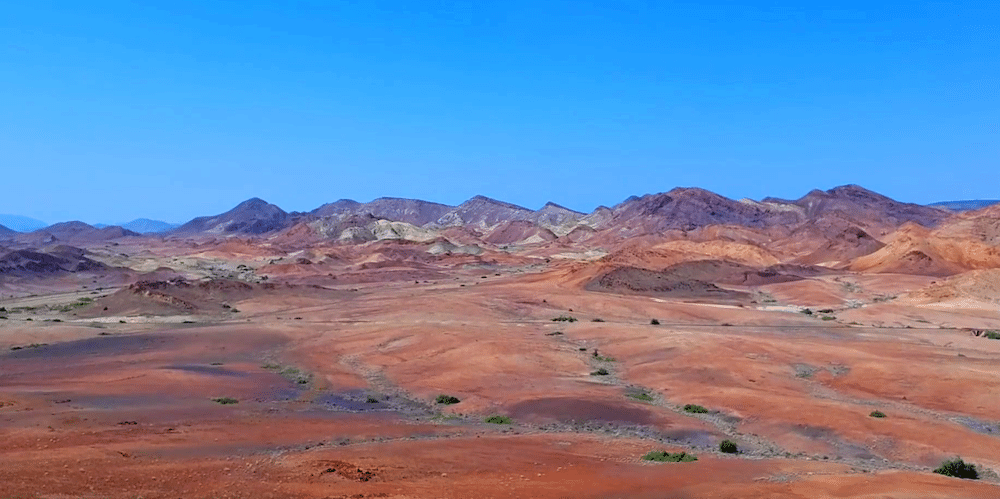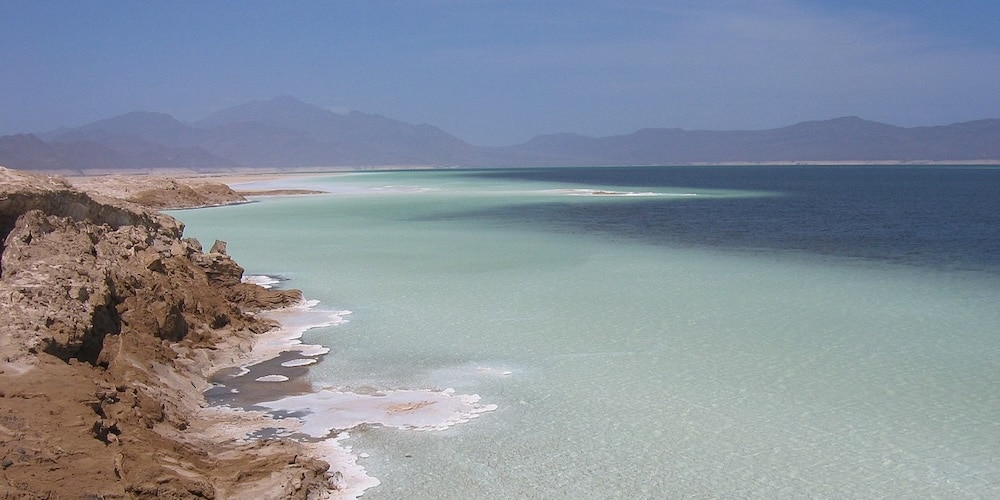Republic of Djibouti

Djibouti is a country in the Horn of Africa, bordered by Somalia to the south, Ethiopia to the southwest, Eritrea in the north, and the Red Sea and the Gulf of Aden to the east. The country has an area of 23,200 km2 (8,958 square miles). It is a multi-ethnic nation with a population of less than 1.2 million (the smallest in mainland Africa). Of whom, three quarters live in the capital Djibouti City. French and Arabic are its two official languages; Afar and Somali are national languages and about 94% of its people are Muslims, predominantly Sunni. It lies near some of the world’s busiest shipping lanes, controlling access to the Red Sea and Indian Ocean. It serves as a key refuelling and transhipment centre and the principal maritime port for imports from and exports to neighbouring Ethiopia.
The country’s coastline stretches 314 kilometres (195 miles), with terrain consisting mainly of plateau, plains and highlands. Djibouti has eight mountain ranges with peaks of over 1,000 metres. The Mousa Ali range is considered the country’s highest mountain range, with the tallest peak on the border with Ethiopia and Eritrea. It has an elevation of 6,654 feet. The Grand Bara desert covers parts of southern Djibouti in the Arta, Ali Sabieh and Dikhil regions. The majority of it sits at a relatively low elevation, below 1,700 feet. Most of Djibouti is part of the Ethiopian xeric grasslands and shrub-lands eco-region. The exception is an eastern strip along the Red Sea coast, which is part of the Eritrean coastal desert.

Mountains near Dasbiyo – ©Skilla1st CC BY-SA 4.0 via Wikimedia Commons
Djibouti’s climate is significantly warmer and has significantly less seasonal variation than the world average. The mean daily maximum temperatures range from 32 to 41 °C, except at high elevations. In Djibouti City, for instance, average afternoon highs range from 28 to 34 °C in April. But at Airolaf, which ranges from 5,036 to 5,249 feet, the maximum temperature is 30 °C in summer and minimum 9 °C in winter. In the uplands ranges from 1,600 to 2,600 feet are comparable and cooler to those on the coast in the hottest months of June until August. December and January is the coolest month with averages low temperatures falling as low as 15 °C. There is either a hot semi-arid climate or a hot desert climate, although temperatures are much moderated at the highest elevations. So climate ranges from arid in the northeastern coastal regions to semi-arid in the central, northern, western and southern parts of the country. On the eastern seaboard, annual rainfall is less than 5 inches; in the central highlands, precipitation is about 8 to 16 inches. The hinterland is significantly less humid than the coastal regions.
Birding Djibouti
The country’s flora and fauna live in a harsh landscape with forest accounting for less than one percent of the total area of the country. Wildlife is spread over three main regions, namely from the northern mountain region of the country to the volcanic plateaux in its southern and central part and culminating in the coastal region.

Day Forest National Park, Goda Mountains – ©Singlab CC BY-SA 3.0 via Wikimedia Commons
Most species are found in the northern part of the country, in the ecosystem of the Day Forest National Park. It covers an area of just 3.5 square kilometres of Juniperus procera forest, with many of the trees rising to 20 metres in height. This forest area is the main habitat of the endangered and endemic Djibouti Francolin and another recently noted vertebrate, Platyceps afarensis (a colubrine snake). It also contains many species of woody and herbaceous plants, including boxwood and olive trees, which account for 60% of the total identified species in the country. According to the country profile related to biodiversity of wildlife in Djibouti, the nation contains more than 820 species of plants, 493 species of invertebrates, 455 species of fish, 40 species of reptiles, 3 species of amphibians, 380 species of birds and 66 species of mammals.
Mammals include several species of antelope, such as Soemmerring’s Gazelle and Pelzeln’s Gazelle. As a result of the hunting ban imposed since early 1970 these species are well conserved now. Other characteristic mammals are Grevy’s Zebra, Hamadryas Baboon and Hunter’s Antelope. The Warthog, a vulnerable species, is also found in the Forest of Day National Park. The coastal waters have dugongs and Abyssinian Genet; the latter needs confirmation by further studies. Green Turtles and Hawksbill Turtles are in the coastal waters where nestling also takes place.

Lake Assal – ©Tyke CC BY 3.0 via Wikimedia Commons
Infrastructure makes it difficult for tourists to travel independently and costs of private tours are high. Djibouti’s two main geological marvels, Lake Abbe and Lake Assal, are the country’s top tourist destinations.
-
Wikipedia
GNU Free Documentation License
https://en.wikipedia.org/wiki/Djibouti
-
Number of bird species: 390
(As at February 2025)
Number of endemics: 1
Ochre-breasted Francolin Pternistis ochropectus
-
Avibase
PDF ChecklistThis checklist includes all bird species found in Djibouti , based on the best information available at this time. It is based on a wide variety of sources that I collated over many years. I am pleased to offer these checklists as a service to birdwatchers. If you find any error, please do not hesitate to report them. -
E-Bird
PDF ChecklistThis checklist is generated with data from eBird (ebird.org), a global database of bird sightings from birders like you. If you enjoy this checklist, please consider contributing your sightings to eBird. It is 100% free to take part, and your observations will help support birders, researchers, and conservationists worldwide. -
Wikipedia
Annotated ListThis is a list of the bird species recorded in Djibouti. The avifauna of Djibouti include a total of 389 species, of which one is endemic, and 3 have been introduced by humans. 19 species are globally threatened.
-
Birds of the Horn of Africa
| (Ethiopia, Eritrea, Djibouti, Somalia and Socotra) | By Nigel Redman, Terry Stevenson & John Fanshawe | Helm | 2011 | Edition 2 | Paperback | 512 pages, 213 colour plates, 1000+ colour distribution maps, colour & b/w maps | ISBN: 9781408157350 Buy this book from NHBS.com

Birds of Africa
AndroidBirds of Africa – an identification guide which in time will cover all the birds and countries in Africa. The latest version of this app is available to download for free from the App Store or Google Play.Useful Information-
BirdLife Data
Webpage
Organisations-
African Bird Club
WebsiteDespite its small size, approximately 23,000 km2, and very limited amount of ornithological study, Djibouti boasts an impressive bird list, with 361 species identified to February 2001. The key to this variety is Djibouti -
Djibouti Nature
WebsiteThe Association Djibouti Nature –Djibouti Nature (formerly known as Wildlife Protection Organization -WPO) is an independent, membership-based and not-for-profit grassroots organization, legally established in Djibouti. Djibouti Nature was set up in 1999 and thus the most and oldest experienced civil society organization working on nature conservation in the country.
Reserves-
IBA Sept-Frères
InformationSatellite ViewThe islands support important breeding Seabird species such as white-eyed and sooty gulls, swift and lesser crested, white-checked, bridled terns and red-billed tropicbird. Osprey and sooty falcon also breed in the islands. -
IBA Îles Musha & Maskali
InformationSatellite ViewThe islands and particularly its satellite islets is known as one of the breeding areas which used by red-billed tropicbird, white-eyed gull, bridled tern, Eurasian spoon bill, osprey, Goliath, striated and western reef herons, chestnut –bellied sandgrouse and possibly some mangrove warblers i.e. clamorous reed warbler. The site is colonized by Indian House Crow and its presence has significant negative impacts on the breeding success of all species. -
Important Bird and Biodiversity Areas
WebpageSatellite ViewImportant Bird and Biodiversity Areas identified for Djibouti consisting 11 sites and cover all the key habitat types in the country. Six (6) of them are by law declared as protected areas (gazetted as terrestrial and marine protected areas). IBAs include two (2) small forested areas, the only remaining woodlands in the country; four (4) wetlands: one (1) inland, two (2) marines and one (1) coastal sites), five (5) semi-arid and arid areas non-declared protected areas yet. Only seven (7) of them are assessed and have been included in the Important Bird Areas of Africa and Associated Islands. -
NP Forêt du Day
InformationSatellite ViewForêt Du Day is the home to 70% of the land based biological diversity and hosts a variety of rare, extremely arid-adapted globally threatened as Critically Endangered Djibouti Francolin, Leopard, Dragon and Livistona trees. Further it has survived for many centuries as biological diversity genetically reservoir and important natural resources to feed and contribute the community livelihood in a highly desert landscape in areas of the Djiboutian dry highlands.
Sightings, News & Forums-
eBird
SightingseBirding This Month
Guides & Tour Operators-
Anbessa
Tour Operator5-day Djibouti Birding Tour -
BirdQuest
Tour OperatorSOMALILAND & DJIBOUTI – Little-known endemics of the Horn of Africa -
Birding Africa
Tour Operator -
Rockjumper
Tour OperatorDjibouti - Extension
Trip Reports-
2012 [09 September] - Nigel Redman
PDF ReportThe second Birdquest tour to Djibouti and Somaliland proved to be as great a success as the first, and our intrepid, well-travelled group was able to enjoy all of the Somaliland endemics and specialities, as well as experience one of the least-known countries in the world. -
2017 [02 February] - David Hoddinott
PDF ReportThe vast mudflats were teeming with birds, an important wintering site for many species. We quickly added numerous species to the list, including Greater Flamingo, Abdim’s Stork, resident population of Eurasian Spoonbill, huge Goliath Heron, Western Reef Heron, Pink-backed Pelican, several Eurasian Oystercatcher, the strange and sought-after Crab-plover, Spur-winged Lapwing... -
2017 [05 May] - David Karr
PDF ReportMy main purpose in visiting was to connect with Crab Plover, a bird that had hitherto eluded me in the Djibouti capital. -
2023 [10 October] - Mark Beaman
PDF ReportOur first real birding not far from Hargeisa turned up a lovely and very unafraid pair of near-endemic Little Brown Bustards, a number of near-endemic Somali Bulbuls and lots of smart, range-restricted Somali Coursers, Somali Beeeaters and Somali Fiscals, not to mention the superb Rosy-patched Bushshrike, Gillett’s Lark, Pale Prinia, Black Scrub Robin and Shining and Nile Valley Sunbirds. Just how tame most birds are in Somaliland soon became obvious to us. The Somalilanders do not generally hunt or eat birds, so the situation is so very different from many parts of the world. A bonus here was Somali Sengi (or Somali Elephant Shrew) although it would just not stay still to be photographed! We also encountered our first African Golden Wolves.
Other Links-
Djibouti Francolin Francolinus ochropectus
WebsiteSpecies profile and conservation status etc
-
Fatbirder - linking birders worldwide...
Skip to content
